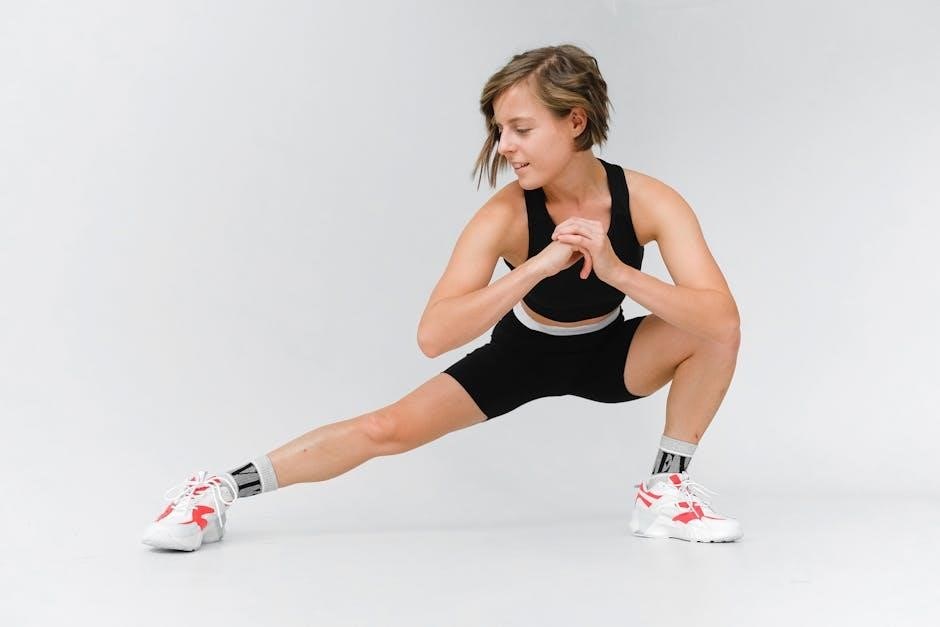Calisthenics is a form of training using body weight for resistance, enhancing strength, flexibility, and cardiovascular health. It requires no equipment, making it accessible to everyone, anywhere.
1.1 What is Calisthenics?
Calisthenics is a form of exercise that uses body weight for resistance, focusing on movements like push-ups, squats, and lunges. Originating with military training, it emphasizes functional strength, flexibility, and cardiovascular health without requiring equipment. Accessible to all fitness levels, calisthenics can be adapted to various goals, from endurance to muscle building, making it a versatile and convenient option for overall fitness. Unlike weight training, it relies on body mechanics and is ideal for those seeking a gym-free workout routine.
1.2 Benefits of Calisthenics Training
Calisthenics training offers numerous benefits, including improved strength, flexibility, and cardiovascular health. It enhances coordination and balance while being low-impact, reducing joint stress. The convenience of needing no equipment makes it accessible anywhere, promoting consistent workouts. It’s cost-effective and adaptable to all fitness levels, from beginners to advanced. Regular practice builds discipline and mental resilience, boosting overall well-being. Its adaptability and efficiency make it an ideal choice for those seeking a versatile and effective workout routine that can be tailored to individual goals and preferences.
Understanding Calisthenics PDF Guides
Calisthenics PDF guides provide comprehensive workout plans, exercises, and routines tailored for all fitness levels. They include step-by-step instructions, tips, and progress tracking, making them ideal for self-guided training.
2.1 Overview of Calisthenics PDF Resources
Calisthenics PDF resources offer a wide range of workout plans, exercise tutorials, and nutritional advice. They cater to all fitness levels, from beginners to advanced athletes. These guides provide structured routines, progressive overload techniques, and tips for consistency. Many include customizable templates, allowing users to tailor workouts to their goals. Resources like 30-day plans, exercise lists, and motivational tips are common. They are easily downloadable and often free, making them accessible to everyone. These PDFs serve as comprehensive tools for building strength, flexibility, and overall fitness without equipment.
2.2 Why Use a Calisthenics PDF Guide?
A calisthenics PDF guide provides a structured and accessible way to plan workouts, track progress, and stay motivated. It offers customizable routines, exercise tutorials, and nutritional advice tailored to fitness goals. PDF guides are ideal for beginners and advanced athletes alike, ensuring consistency and progression. They are often free, easily downloadable, and require no special equipment. Using a calisthenics PDF guide helps users stay organized, focused, and committed to their fitness journey, making it easier to achieve strength, flexibility, and overall well-being.
Structure of a Calisthenics Workout Plan
A well-structured calisthenics plan includes progressive routines, warm-ups, and exercises targeting upper body, lower body, and core. It balances intensity, recovery, and consistency for optimal results.
3.1 Beginner-Friendly Calisthenics Routines
Beginner-friendly calisthenics routines focus on basic bodyweight exercises like push-ups, squats, and planks. These routines are designed to build foundational strength and endurance gradually. They often include step-by-step guides and progressions, ensuring safety and effectiveness. Many free PDF resources provide structured plans, starting with simple movements and slowly introducing more complex exercises. These routines are perfect for newcomers, as they require no equipment and can be done anywhere. Consistency and proper form are emphasized to avoid injuries and promote steady progress.
3.2 Intermediate and Advanced Calisthenics Exercises
Intermediate and advanced calisthenics exercises challenge individuals with more complex movements, such as pull-ups, single-leg squats, and dynamic core exercises. These routines aim to enhance strength, power, and flexibility. PDF guides often include detailed progressions, allowing users to gradually increase difficulty. Advanced exercises may incorporate explosive movements like muscle-ups or plyometric push-ups. Proper form and consistency are crucial to avoid injuries and maximize results. These exercises are ideal for those who have mastered the basics and are ready to push their limits.
30-Day Calisthenics Workout Plan
A structured 30-day plan designed to build endurance and strength gradually. Perfect for beginners or those restarting their fitness journey, it offers a step-by-step guide without needing equipment.
4.1 Weekly Breakdown of the 30-Day Routine
The 30-day calisthenics plan is divided into four weekly segments, each focusing on progressive overload and muscle development. Week 1 builds a foundation with basic exercises like push-ups, squats, and planks. Week 2 introduces variations and increases reps, while Week 3 emphasizes full-body workouts and core strength. Week 4 focuses on mastery and incorporating advanced moves. The routine includes five sessions per week, with rest days for recovery. Each day targets specific muscle groups, ensuring balanced growth and overall fitness improvement.
4.2 Tips for Consistency and Progress
Consistency is key to seeing progress in calisthenics. Create a schedule and stick to it, ensuring regular workouts. Track your progress using a calisthenics PDF guide to monitor improvements. Gradually increase reps, sets, or difficulty as you build strength. Focus on proper form to prevent injuries and maximize results. Incorporate rest days to allow muscle recovery and growth. Stay motivated by setting realistic goals and celebrating milestones. A balanced diet and adequate sleep further support your training journey, helping you achieve long-term success and consistent progress.

Calisthenics Exercises for Full-Body Development
Calisthenics offers a variety of exercises targeting all major muscle groups, improving overall fitness without equipment. From push-ups to squats, these movements enhance strength, flexibility, and coordination effectively.
5.1 Upper Body Exercises (Push-Ups, Chin-Ups, etc.)
Upper body calisthenics exercises are essential for building strength and endurance. Push-ups target the chest, shoulders, and triceps, while chin-ups focus on the back and biceps. Variations like wide-grip push-ups emphasize the chest, and assisted chin-ups help beginners progress. Dips, performed on parallel bars or at home, work the triceps and chest. These exercises improve posture, enhance athletic performance, and contribute to a well-rounded physique. Incorporating these movements into your routine ensures comprehensive upper body development without needing heavy equipment.
5.2 Lower Body Exercises (Squats, Lunges, etc.)
Lower body calisthenics exercises, such as squats and lunges, are foundational for building strength and power. Squats work the quadriceps, hamstrings, and glutes, improving balance and mobility. Lunges target the same muscles but add a focus on unilateral strength and coordination. Variations like pistol squats and step-ups challenge even advanced practitioners. These exercises enhance athletic performance, improve posture, and contribute to overall lower body development. Incorporating them into your routine ensures a strong, balanced physique without the need for specialized equipment.
5.3 Core and Flexibility Exercises
Calisthenics emphasizes core strength and flexibility through exercises like planks, Russian twists, and leg raises. These movements stabilize the body, enhancing posture and reducing injury risk. Flexibility exercises, such as hamstring stretches and hip flexor stretches, improve range of motion and overall mobility. Incorporating dynamic stretches and holds into routines ensures a balanced approach to fitness. These exercises are essential for maintaining proper form in other calisthenics movements and contribute to long-term physical health and performance.

Downloadable Calisthenics PDF Templates
Access free, customizable PDF templates designed for calisthenics workout planning. These guides offer structured routines, exercise lists, and progress tracking, perfect for all fitness levels.
6.1 Free PDF Templates for Workout Planning
Download free calisthenics PDF templates designed to help you plan and organize your workouts effectively. These templates provide structured routines, exercise lists, and tracking features to monitor progress. Customize them according to your fitness goals, whether you’re a beginner or advanced. Printable and easy to use, they include space for setting targets, logging sets, reps, and weights. Perfect for creating a personalized fitness plan, these templates ensure consistency and motivation, helping you stay on track with your calisthenics journey.
6.2 How to Customize Your Calisthenics PDF
Customizing your calisthenics PDF allows you to tailor workouts to your fitness level and goals. Adjust exercises, sets, and reps based on your progress. Add personal goals, nutritional advice, and progress tracking. Printable and editable templates make it easy to modify routines. Use examples like push-ups or squats and adapt them to suit your needs. This flexibility ensures your workout plan remains effective and engaging, helping you progress from beginner to advanced levels seamlessly.

Nutrition and Recovery for Calisthenics
A balanced diet, proper hydration, and adequate rest are crucial for calisthenics success. Focus on nutrient-rich foods to support muscle growth and recovery, ensuring optimal performance and overall well-being.
7.1 Diet Tips to Support Calisthenics Training
A well-structured diet is essential for optimal calisthenics performance. Focus on whole, nutrient-dense foods like lean proteins, complex carbs, and healthy fats to fuel workouts and aid recovery.
- Stay hydrated to maintain energy levels and support muscle function.
- Incorporate protein-rich foods to build and repair muscle tissue.
- Include complex carbohydrates for sustained energy during sessions.
- Add healthy fats for hormone balance and overall health.
- Avoid processed foods and sugary snacks to prevent energy crashes.
Consistency in nutrition is key to achieving calisthenics goals and maintaining peak physical condition.
7.2 Importance of Rest and Recovery
Rest and recovery are crucial for muscle growth and overall performance in calisthenics. Adequate rest allows your body to repair and strengthen muscles, preventing overtraining and injury. Ensure 7-9 hours of quality sleep nightly, as this is when recovery processes peak. Incorporate active recovery techniques like stretching or light cardio to improve circulation and flexibility. Nutrition also plays a role; consume sufficient protein and carbohydrates to aid muscle repair. Consistent rest and recovery routines enhance progress and maintain long-term physical health.

Avoiding Injuries in Calisthenics
Proper warm-ups, maintaining correct form, and gradual progression are key to preventing injuries. Listen to your body and rest when needed to avoid strain and ensure safety.
8.1 Common Injuries and Prevention Tips
Common injuries in calisthenics include muscle strains, joint pain, and overuse injuries. These often occur due to poor form, overtraining, or insufficient warm-ups; To prevent injuries, focus on proper technique, gradual progression, and adequate rest. Incorporate dynamic stretches and strength-building exercises to enhance stability and flexibility. Listening to your body and avoiding excessive repetition can significantly reduce the risk of injury. Prioritize quality over quantity to ensure long-term progress and safety in your calisthenics journey.
- Warm up thoroughly before workouts.
- Master proper form and technique.
- Progress gradually and avoid overtraining.
- Incorporate rest and recovery days.
8.2 Warm-Up and Cool-Down Routines
A proper warm-up prepares the body for exercise, reducing injury risk and improving performance. Start with light cardio like jumping jacks or jogging, followed by dynamic stretches such as arm circles, leg swings, and torso twists. For cool-down, focus on static stretches to improve flexibility and promote recovery. Include stretches for major muscle groups like hamstrings, quadriceps, and chest. A well-structured warm-up and cool-down routine enhances overall training efficiency and supports long-term fitness goals.
- 5-10 minutes of light cardio to increase heart rate.
- Dynamic stretches to activate muscles.
- Static stretches post-workout for flexibility.
- Breathing exercises to relax the mind and body.
Calisthenics is an empowering, transformative way to build strength and fitness. Consistency and patience will unlock its full potential, leading to a healthier, more confident you.
9.1 Final Thoughts on Calisthenics Training
Calisthenics training is a powerful, effective way to transform your body and mind. It builds strength, flexibility, and cardiovascular health without needing equipment. Suitable for all fitness levels, it fosters mental discipline and resilience. The availability of detailed PDF guides makes it easy to follow structured plans, ensuring progress and consistency. Embrace calisthenics for a holistic fitness journey that empowers you to achieve your goals and maintain a healthy lifestyle. Start your calisthenics journey today and unlock your full potential!
9.2 Encouragement to Start Your Calisthenics Journey
Starting your calisthenics journey is a life-changing decision that brings strength, confidence, and overall well-being. With accessible PDF guides, you can begin anywhere, anytime, without equipment. Embrace the journey, stay consistent, and celebrate small victories. Calisthenics is for everyone, regardless of fitness level, offering a path to transform your body and mind. Take the first step today, and let the power of bodyweight training empower you to achieve your goals and live a healthier, more fulfilling life.
